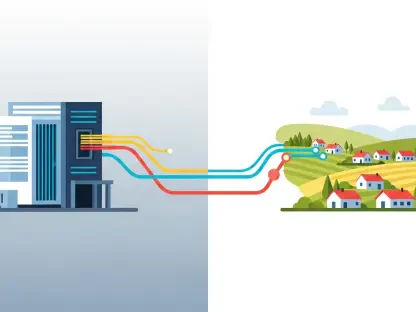Unpacking the Spectrum Policy Crisis in India’s Telecom Sector
The Indian telecommunications market, a vital engine of the nation’s digital economy, stands at a critical juncture with spectrum policy emerging as a defining issue. With over 1.1 billion mobile subscribers and data consumption soaring, the sector’s ability to deliver seamless connectivity hinges on access to affordable and efficiently allocated spectrum. Major players like Reliance Jio, Bharti Airtel, and Vodafone Idea have raised alarms over systemic barriers in current policies, arguing that without urgent reforms, the industry risks stunted growth and diminished global competitiveness. This market analysis delves into the pressing need for spectrum policy overhaul, examining key trends, data-driven insights, and projections that could shape the future of telecom in India. The stakes are high, as reforms could unlock billions in investments and redefine consumer experiences in one of the world’s largest telecom markets.
Deep Dive into Market Dynamics and Spectrum Policy Challenges
Historical Context and Auction Inefficiencies
The Indian telecom market has undergone significant transformation over recent decades, consolidating from a fragmented landscape of numerous operators to a tightly contested space dominated by three major players. This shift, driven by intense competition and financial pressures, has been exacerbated by the high costs of spectrum acquisition through government auctions. Data from the Department of Telecommunications reveals a persistent issue: nearly 49% of spectrum instances across multiple auctions since the introduction of the auction system have gone unsold, with only a small fraction fetching premium prices. High reserve prices and inflexible terms have deterred participation, creating a bottleneck for telecom companies seeking to expand capacity amid rising data demands. This historical inefficiency underscores the urgent need for policy recalibration to align with market realities.
Financial Strain from High Reserve Prices
A dominant concern in the market is the burden of exorbitant reserve prices for spectrum, which telecom companies argue stifles investment and limits competitive dynamics. Industry reports highlight that Indian operators face a spectrum cost-to-revenue ratio of approximately 26%, one of the highest globally, placing immense pressure on their balance sheets. Proposals from leading players suggest reducing reserve prices to a fraction of current valuations to encourage broader auction participation and ensure pricing reflects true market demand. Lower costs could redirect capital toward critical infrastructure upgrades, such as fiber networks and 5G rollout, which are essential for meeting consumer expectations. Without such reforms, the risk of unsold spectrum persists, hampering both government revenue and industry growth.
Demand for Extended Spectrum Validity Periods
Another pivotal trend shaping market discourse is the push for longer spectrum validity periods, currently capped at 20 years. Telecom companies advocate for extensions to 30 or 40 years to provide certainty for long-term planning and reduce the financial strain of frequent renewals at potentially inflated costs. Such a shift would align India with global practices in several advanced markets, allowing operators to amortize investments over extended timelines. This reform is seen as a cornerstone for sustaining network expansion and supporting next-generation technologies. However, policymakers must balance this demand against the potential delay in government revenue, a challenge that requires innovative fiscal strategies to maintain equilibrium.
Diverging Strategies on Auction Bands and Participation Rules
Market players exhibit varied strategic priorities when it comes to spectrum bands and auction participation frameworks. Some advocate for immediate auctioning of all available bands, including emerging frequencies like 6GHz, to foster innovation in areas such as direct-to-device connectivity and non-terrestrial networks under future 6G frameworks. Others caution against rushing into newer bands, proposing a phased approach to evaluate market readiness over the next couple of years. Additionally, discussions around allowing non-traditional participants, such as Internet Service Providers, into auctions to address unsold spectrum introduce further complexity. These differences reflect the diverse business models within the sector, highlighting the challenge of designing a cohesive policy that accommodates varied interests while preventing artificial scarcity.
Emerging Trends and Future Market Projections
Looking at current market trajectories, the Indian telecom sector grapples with financial constraints and limited returns on 5G investments, even as data consumption continues to surge. Emerging trends point to an increasing reliance on spectrum for innovative applications, including software-defined networks and satellite-supported connectivity, which could redefine coverage models in rural and urban areas alike. Projections suggest that without policy reforms—such as reduced reserve prices or extended validity periods—the sector may struggle to attract the capital needed for these advancements, potentially lagging behind global peers by 2027. Regulatory shifts could unlock significant investments, with estimates indicating that a more flexible spectrum framework might boost infrastructure spending by double-digit percentages over the next few years.
Technological evolution also plays a crucial role in shaping market forecasts. The transition toward 6G and associated technologies demands a spectrum policy that anticipates future needs rather than reacting to present constraints. Economic pressures on the government to maximize auction revenue must be weighed against the imperative to foster a competitive environment that drives innovation. Analysts anticipate that alternative models, such as revenue-sharing mechanisms in lieu of upfront payments, could emerge as viable solutions, offering a middle ground that supports both fiscal goals and industry health. The trajectory of these trends will likely determine whether India solidifies its position as a digital powerhouse or risks widening the connectivity gap.
Reflecting on Insights and Strategic Pathways Forward
This analysis uncovered critical challenges and opportunities within the Indian telecom market, particularly around spectrum policy inefficiencies that have long hindered growth. The persistent issue of high reserve prices and short validity periods has constrained telecom companies’ ability to invest in infrastructure, while historical auction data paints a stark picture of systemic barriers with significant unsold spectrum. Divergent strategies among major players have further complicated the path to unified reform, yet the collective push for change underscores a shared vision for a sustainable sector.
Moving forward, actionable steps emerge as essential for stakeholders. Policymakers are urged to prioritize lowering reserve prices and extending spectrum validity to align with global benchmarks, fostering an environment conducive to investment. Telecom companies, in turn, need to strengthen collaborative efforts through industry bodies to present cohesive reform proposals that balance individual and collective goals. For businesses and consumers dependent on robust connectivity, advocacy and engagement in regulatory discussions become vital to ensure policies reflect real-world needs. These strategic pathways offer a roadmap to transform past challenges into future successes, setting the stage for a revitalized telecom landscape in India.









